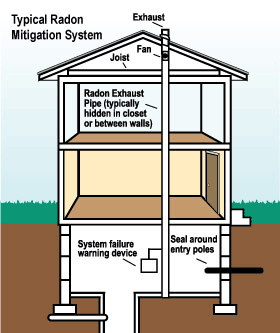Radon is the second leading cause of lung cancer in the United States. A radon reduction system (radon mitigation) reduces high levels of indoor radon to acceptable levels. The system most frequently used is a vent pipe system and fan, which pulls radon from beneath the house and vents it to the outside.
The U.S. Environmental Protection Agency (EPA) reports that the average radon mitigation costs about $1,200, but can range from $800 to $2,500, depending on the complexity of the home, the home’s radon level, and local labor and material costs.
The State of Georgia currently has no requirement that radon mitigators be certified. The University of Georgia College of Family and Consumer Sciences Radon Education Program provides helpful guidelines while urging consumers to be proactive when selecting a radon mitigator. Our purpose is to provide the consumer with recommendations, which are in no way regulatory.
Recommendations Prior to Mitigation
The Homeowner Should:
- Find certified radon mitigation professionals (radon.uga.edu). We recommend the use of radon mitigators who are certified by the NRSB (National Radon Safety Board) or the NRPP (National Radon Proficiency Program).
- Obtain more than one mitigation estimate in writing.
- Request references to determine if previous clients were satisfied with the mitigator’s work. Ask those providing references whether the radon level in their home was above 4.0 picocuries per liter (pCi/L) prior to mitigation, and whether it was reduced to below 4.0 pCi/L after mitigation.
The Mitigator Should:
- Provide proof of NRPP or NRSB certification and proof of liability insurance.
- Explain how the radon reduction system operates, how long the work will take, and where the system will be located.
- Inspect the home’s structure prior to giving an estimate.
- Agree to have the home tested for radon following the installation to ensure the system is effective.
- Agree to install a warning device to caution you if the system is not working properly.
- Guarantee to reduce the radon level below 4.0 pCi/L.
- Review your radon measurement results and determine if appropriate procedures were followed.
Mitigation Contract
Ask the mitigator to prepare a written contract that includes:
- Total cost of the job and when payment is due in full.
- Time needed to complete the work.
- A guarantee that the contractor is responsible for any damage during the job and cleanup afterward.
- An agreement to obtain any necessary permits and to follow required building codes.
- Details on the radon reduction system to be installed.
- Information on any warranties associated with the hardware components of the mitigation system and whether warranties are transferable if the home is sold.
- A statement that the contractor carries liability insurance and is bonded to protect you in case of injury to persons or damage to property while working.
Recommendations During and After Installation of Mitigation System
- Radon reduction system must be clearly labeled.
- The exhaust pipe of soil suction systems must vent above the surface of the roof and 10 ft or more above the ground, and at least 10 ft away from windows, doors, or other openings that could allow the radon to re-enter the house.
- The exhaust fan must not be located in or below a livable area. It can be in an unoccupied attic or outside the house, but should not be in a basement.
- Exhaust fan and electrical connections must be installed according to the local building and electrical codes.
- A warning device should be installed to alert the homeowner of a non-working system. Examples of warning systems include liquid gauges, sound alarms, light indicators, or needle display gauges.
- A post-mitigation radon test is done within 30 days of installation and no sooner than 24 hr after system completion. A 2- to 7-day radon test is recommended with closed house conditions (exterior doors and windows closed).
- The mitigator should explain the system and demonstrate how it operates and how to maintain it.
- The homeowner should re-test every 2 years.
UGA Radon Education Program
radon.uga.edu • 1-800-ASK-UGA1
The UGA Radon Education Program is funded by the U.S. Environmental Protection Agency State Indoor Radon Grant Program. Published by University of Georgia Cooperative Extension. For more information or guidance, contact your local Extension office.
Reference
U.S. Environmental Protection Agency. (2016). A citizen’s guide to radon. https://www.epa.gov/sites/default/files/2016-12/documents/2016_a_citizens_guide_to_radon.pdf
This publication is based on previous manuscripts by Rebecca Chenhall, Pamela Turner, Morgan Barnett, and Jorge Atiles
Status and Revision History
Published with Full Review on Jul 11, 2015
Published with Full Review on Jul 20, 2022


























































